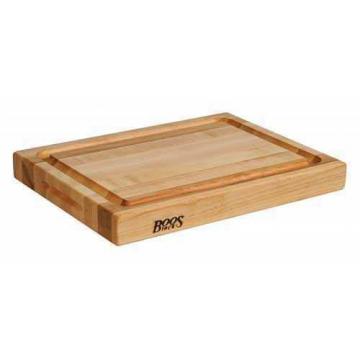
Cutting Boards
A good cutting board is essential for good knives. It is immensely important for your knives, and besides, cutting on it is also more fun. As is often the case, opinions on the material differ widely. Wood, plastic, glass, or stone? Butch helps and explains the differences. Afterward, you will know why we at Butch prefer wooden cutting boards.
The Materials
Glass or Stone
Please keep your hands off. These materials may be easier to clean and more durable, but they take a toll on the knife blades. Since stone and glass do not yield, the blades become dull much faster. And dull knives, logically, do not cut well.
Plastic
Plastic boards are considered hygienic and easy to care for, as they are mostly dishwasher safe. This is basically true, but if there are deep grooves on the surface, bacteria can also accumulate here if not cleaned properly. In terms of lifespan, you have two options. Either you choose a cutting board made of hard or soft plastic. Soft plastic quickly becomes unsightly but is good for your knives. Hard plastic increases the lifespan but is bad for the blades. Refurbishing plastic boards is very labor-intensive and not worth the price.
Bamboo
Nowadays, countless cutting boards are made from bamboo. Bamboo is a fast-growing and inexpensive raw material that can also be easily processed. During manufacturing, many small pieces cut across the grain are glued together. The second variant is three-layered: Here, two plates with larger longitudinal pieces are produced. In the middle between the plates, small pieces cut across the grain are inserted. Since bamboo contains no tannic acid, thorough cleaning of bamboo boards is essential. Some see the enormous hardness as an advantage, but it is rather a disadvantage. Knives with finely ground blades wear out faster.
Wood
Our favorite and first choice are cutting boards made of wood. Good cutting boards use wood with a high tannic acid content, such as oak, walnut, cherry, and maple wood. The high tannic acid content has an antibacterial effect, inhibiting germ formation. Woods like rubber tree, acacia, and beech are also used for cutting boards. However, the tannic acid content of these woods is relatively low. They are also rather soft, which leads to deep cuts more quickly. Regardless of the wood used, thorough cleaning and proper care are mandatory. We will address proper cleaning later in the Cleaning & Care section.
For deep cuts, thick wooden boards can be sanded down by most carpenters and look like new afterward. This is why wooden boards, in particular, boast a long lifespan. And the thicker a board is, the more often it can be sanded down.










